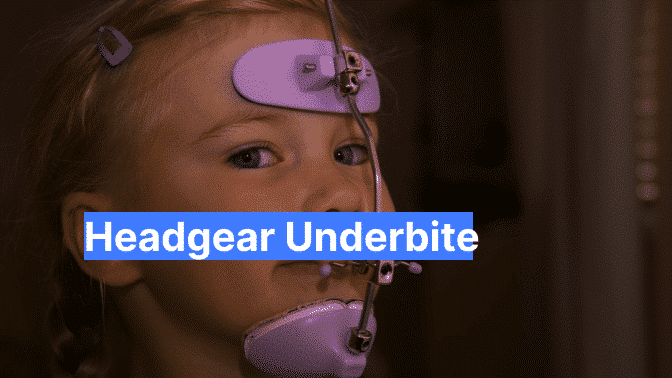An underbite, also known as prognathism, is a dental condition where the lower jaw extends beyond the upper jaw when the mouth is closed.
This misalignment can impact both the appearance and function of the jaw, leading to difficulties in chewing, speech problems, and jaw pain.
Fortunately, there are various treatment options available to correct underbites, and one commonly used method is headgear.
In this comprehensive guide, we will explore the different aspects of headgear as a treatment for underbite correction.
Understanding Underbites:
An underbite occurs when the lower jaw protrudes forward, causing the teeth in the lower jaw to overlap the upper teeth. This condition can have genetic causes, developmental factors, or a combination of both. It is crucial to address underbites as they can lead to problems with bite alignment, oral health, and self-confidence.
Headgear as a Treatment Option:
Headgear is an orthodontic appliance used in underbite correction. It consists of a head cap or a neck strap that connects to wires and brackets attached to the teeth. Headgear exerts gentle pressure on the upper jaw, guiding it backwards and allowing the lower jaw to align properly.
There are different types of headgear available, including cervical pull headgear, high-pull headgear, and reverse-pull headgear, each designed to address specific underbite conditions.
Benefits and Potential Drawbacks of Using Headgear:
Using headgear as a treatment for underbite correction offers several benefits, but it’s important to consider potential drawbacks as well. Understanding both sides can help you make an informed decision about whether headgear is the right option for you. Here are some benefits and drawbacks of using headgear:
- Effective Underbite Correction: Headgear is a proven method for correcting underbites. It applies gentle pressure to the upper jaw, gradually guiding it backwards and allowing the lower jaw to align properly. With consistent usage and proper adjustments, headgear can effectively address underbite misalignment.
- Improved Bite Function: By aligning the jaws properly, headgear helps improve bite function. This can enhance chewing efficiency, alleviate jaw discomfort, and reduce the risk of temporomandibular joint (TMJ) issues. A properly aligned bite also promotes better overall oral health.
- Enhanced Facial Aesthetics: Underbites can affect the facial profile and smile aesthetics. By correcting the underbite, headgear can contribute to a more balanced and harmonious facial appearance, boosting self-confidence and improving overall facial aesthetics.
- Non-Surgical Approach: Headgear offers a non-surgical treatment option for underbite correction. It eliminates the need for invasive procedures and potential associated risks. This makes it an attractive option for individuals who prefer non-surgical interventions or want to avoid more extensive treatments.
- Prevents Further Complications: Addressing underbites with headgear can help prevent future complications. Untreated underbites can lead to issues such as excessive tooth wear, speech difficulties, and TMJ disorders. Headgear treatment aims to correct the underbite, reducing the risk of these potential complications.
Potential Drawbacks and Considerations:
- Discomfort and Adjustments: Wearing headgear can initially cause discomfort and require a period of adjustment. The pressure and sensation on the teeth and jaw may take some getting used to. However, with time and proper adjustment, most individuals adapt to wearing headgear comfortably.
- Compliance and Consistency: Successful underbite correction with headgear requires consistent and diligent usage. Adhering to the prescribed wear schedule, including overnight usage, is essential for optimal results. Some individuals may find it challenging to consistently comply with the recommended usage, which can impact treatment effectiveness.
- Impact on Lifestyle: Wearing headgear may temporarily impact certain activities or lifestyle choices. For example, it may be necessary to modify eating habits, avoid certain physical activities, or be mindful of the appearance of headgear in social situations. These considerations should be taken into account when deciding on headgear treatment.
Suitability and Candidacy for Headgear Treatment:
Determining whether headgear is the right treatment option for you requires a thorough evaluation by an orthodontist. Factors such as age, severity of the underbite, jaw growth, and overall dental health are taken into consideration. Your orthodontist will assess your specific case and recommend the most suitable treatment plan, which may or may not include headgear.
Duration and Frequency of Headgear Usage:
The duration of headgear treatment varies depending on the severity of the underbite and the individual’s response to treatment. On average, headgear is worn for a specified number of hours per day, typically during evenings and while sleeping.
Your orthodontist will provide precise instructions on the duration and frequency of headgear usage. It’s essential to follow these instructions diligently to achieve optimal results.
Read Also: Express Invisalign: Fast and Convenient Teeth Straightening Solution
Tips and Recommendations for Wearing Headgear Comfortably:
Wearing headgear for underbite correction can initially feel uncomfortable or unfamiliar. However, with proper adjustments and care, you can make the experience more comfortable and manageable. Here are some tips and recommendations to help you wear headgear comfortably:
- Proper Fitting and Adjustment: Ensure that the headgear is properly fitted by your orthodontist. The straps or neck pad should be snug but not overly tight, and the appliance should be positioned correctly on your head.
- Gradual Introduction: Ease into wearing headgear by gradually increasing the duration of usage as recommended by your orthodontist. Start with shorter periods and gradually extend the time each day. This allows your mouth to adjust more comfortably.
- Consistent Usage: Follow the prescribed wear schedule provided by your orthodontist. Consistency is key to achieving the desired results. Avoid skipping or excessively prolonging the time you wear the headgear, as this may delay progress.
- Maintain Oral Hygiene: Practice good oral hygiene to keep your mouth clean and healthy while wearing headgear. Brush your teeth thoroughly and floss regularly to remove any food particles or plaque buildup. Pay extra attention to the areas around the headgear, ensuring they are clean and free from debris.
- Soft Diet: During the initial adjustment period, opt for a softer diet that minimizes excessive chewing or biting forces. This can help reduce discomfort and pressure on the jaw while wearing headgear.
Potential Side Effects and How to Manage Them:
While headgear is generally a safe and effective treatment for underbite correction, it’s important to be aware of potential side effects that may arise during the treatment process.
Understanding these side effects and knowing how to manage them can help ensure a more comfortable experience. Here are some common side effects and tips for managing them:
- Discomfort and Soreness: It’s normal to experience some discomfort or soreness when wearing headgear, especially during the initial adjustment period. This discomfort usually subsides as your mouth adapts to the appliance. To manage this, you can try:
- Pressure on Teeth: Headgear exerts gentle pressure on the teeth and jaw to facilitate proper alignment. While this pressure is necessary for the treatment, it can sometimes cause temporary discomfort or sensitivity in the teeth. To manage this:
- Speech Difficulties: Wearing headgear may temporarily affect your speech, causing minor changes in pronunciation or lisping. This is normal as your mouth adjusts to the presence of the appliance. Here are some tips to help manage speech difficulties:
- Skin Irritation: The headgear’s straps or pads may sometimes cause irritation or redness on the skin where they come into contact. To address this:
Effectiveness and Success Rates of Headgear in Underbite Correction:
Numerous studies and scientific evidence support the effectiveness of headgear in underbite correction. Success rates vary depending on the individual case, compliance with usage instructions, and proper orthodontic care. Your orthodontist will monitor your progress regularly, making any necessary adjustments to ensure the treatment’s success.
Combining Headgear with Other Orthodontic Treatments:
In some cases, the headgear may be used in conjunction with other orthodontic treatments to achieve optimal results. Braces or other appliances may be recommended to address specific dental issues or facilitate jaw alignment. Your orthodontist will develop a comprehensive treatment plan tailored to your needs.
Case Studies and Success Stories:
Real-life examples of individuals who have successfully used headgear for underbite correction can provide valuable insight and inspiration. Before and after photos can showcase the transformative power of headgear and motivate individuals to consider this treatment option.
Conclusion
Headgear is a valuable tool in correcting underbites, offering a non-surgical approach to realigning the jaw and improving both function and aesthetics. While it requires commitment and diligence, the benefits of headgear treatment can be significant.
By understanding the various aspects of headgear usage and its effectiveness, individuals with underbites can make informed decisions about their treatment options.
Consultation with an experienced orthodontist is crucial for determining the suitability of headgear and ensuring optimal results. Remember, a properly aligned jaw not only enhances your smile but also contributes to overall oral health and well-being.
FAQ 1: Q: When should I go to the ER for an abscessed tooth?
A: It is recommended to go to the emergency room for an abscessed tooth if you experience severe symptoms such as difficulty breathing or swallowing, swelling that affects your ability to open your mouth, high fever, or signs of spreading infection like redness and warmth in the face or neck. These symptoms may indicate a potentially life-threatening situation that requires immediate medical attention.
FAQ 2: Q: Can I wait to see a dentist for an abscessed tooth or should I go to the ER?
A: In most cases, it is best to see a dentist for an abscessed tooth rather than going to the emergency room. Dentists are specialized in dental conditions and can provide the appropriate treatment for the abscess, such as draining the infection and prescribing antibiotics. However, if you are experiencing severe symptoms or if it is outside of regular dental office hours, going to the ER is advisable.
FAQ 3: Q: What can the emergency room do for an abscessed tooth?
A: The emergency room can provide temporary relief for an abscessed tooth by prescribing antibiotics to control the infection and pain medication to manage your discomfort. They may also perform minor procedures such as draining the abscess to alleviate swelling and pressure. However, it's important to follow up with a dentist for definitive treatment as soon as possible.
FAQ 4: Q: How do I know if I have an abscessed tooth that requires emergency care?
A: Some common signs of an abscessed tooth include severe toothache, persistent throbbing pain, swelling in the gums or face, fever, foul taste or odor in the mouth, and difficulty opening the mouth or swallowing. If you are experiencing any of these symptoms, it's recommended to seek dental or emergency care for proper diagnosis and treatment.
FAQ 5: Q: Can an abscessed tooth be life-threatening?
A: Yes, an abscessed tooth can potentially be life-threatening if the infection spreads beyond the tooth and jawbone. The infection can progress to the surrounding soft tissues, leading to a condition called cellulitis, or it can spread to the deeper spaces of the head and neck, causing a serious condition known as Ludwig's angina. These situations require immediate medical attention and may be treated in the emergency room.




